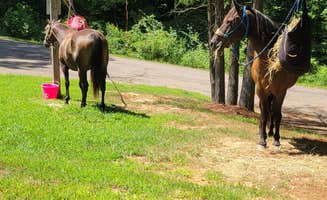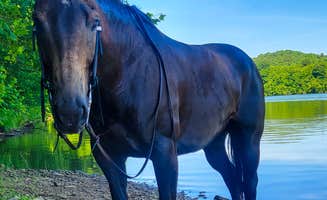Equestrian campgrounds dot the landscape near Cumberland, Ohio, offering riders access to forest trails through the Appalachian foothills. The region features rolling terrain with elevations ranging from 800-1,200 feet and a mix of deciduous forests. Most horse trails remain open from April through November, with peak conditions in late spring and early fall when rainfall keeps dust levels manageable.
What to do
Trail riding at Blue Rock State Park: The trails at Blue Rock State Park Campground accommodate riders of various skill levels through forested terrain. "Lovely park near Zanesville. The park is beautiful, lots of wildlife, and the trails were great," notes Ryan W., who appreciated the natural setting and well-maintained paths.
Fishing at multiple locations: Most campgrounds in the region offer fishing opportunities in stocked lakes. "Great fishing, disappointed camping," reports JG S. about Strouds Run State Park, highlighting that while the camping facilities weren't ideal, the fishing made the trip worthwhile.
Mountain biking on designated trails: Several parks maintain dual-use trails for both horses and mountain bikes. At Mountwood Park Family Campground, visitors can access "a solid collection of varied ability MTB trails" according to Dave V., who found the trails suitable for different experience levels.
Historical exploration: The region contains interesting historical sites within short drives of camping areas. At Old Stone Church Campground, visitors can explore remnants of the area's past. "A short distance further down the road, just after it turns to gravel, at the Old Stone Church trailhead," describes Tammy F., explaining the layout of this historical area.
What campers like
Spacious horse camping sites: Walkabout Creek Horsemans Camp provides dedicated facilities for equestrians with ample room for trailers. "Great great campground plenty to Joe we took the horses had a blast," shares Cheryl C., highlighting the positive experience for equestrians.
Lake access for cooling off: Several parks feature lakes with beach areas or boat launches. At Dillon State Park Campground, "The picnic area appeared well kept," according to Linda B., though she notes that swimmers should check for water advisories before planning water activities.
Quiet camping options: Some areas offer more secluded camping experiences away from busier sites. "Small campground, lower camp sites are pretty close together but it's treed and shady with a creek running through. No one was here during our stay so felt like we had the campground to ourselves," writes Megan P. about her experience at Blue Rock.
Clean facilities: Many campers mention the condition of bathrooms and shared spaces. "Bathrooms and showers were relatively clean and accommodating," notes Seána B. about Mountwood Park, which matters to riders after a long day on the trails.
What you should know
Varying site quality: Campsite conditions can differ substantially within the same campground. At Strouds Run State Park Campground, "Sites are only rented in person once you arrive, they have clear instructions at the entrance. Sites were nice and level, but a bit on the smaller side," according to Isaac K.
Limited utilities: Not all campgrounds offer full hookups or modern amenities. "There are pit toilets, potable water towards the front, and that's it," explains Megan M. about Strouds Run, emphasizing the primitive nature of some facilities.
Seasonal considerations: Weather affects trail conditions significantly throughout the year. "We were here Columbus weekend and it was hopping but everyone quieted by 10," shares Ralph P. about Salt Fork State Park, indicating that fall weekends can be busy but manageable.
Shower availability: Facilities vary widely between parks, with some offering no showers. At Kinderhook Horse Trail, "The bathroom was clean, but the 'non-flush' toilet was just gross," reports Harley G., highlighting the rustic nature of this free camping area.
Tips for camping with families
Kid-friendly activities: Look for campgrounds with dedicated facilities for children. At Burr Oak State Park Campground, "There is a swingset across the road in the main campground," notes Leon H., which provides entertainment for younger campers.
Swimming beaches: Several parks feature designated swimming areas. "The park features a beach volleyball area, and bathrooms," Lucille W. says about Strouds Run, though she cautions that "Sometimes the water isn't very clean" and advises checking conditions.
Wildlife viewing opportunities: The region hosts diverse wildlife for nature observation. "Just driving in saw turkeys and 'turkets':) and two 6 point bucks," reports Shelly S., highlighting the wildlife viewing opportunities at Salt Fork.
Educational experiences: Some parks offer natural history programs. "There is a cool, little local WV Oil history museum. Being a bit of a history buff, I was fascinated by the museum," Dave V. writes about Mountwood Park, noting this additional educational option.
Tips from RVers
Site selection strategy: Choosing the right site can significantly improve your camping experience. "We stayed in G loop (G33) and were more than satisfied with the site," mentions Jay B. about Salt Fork State Park, suggesting specific loops that work well for RVs.
Seasonal crowds: Timing affects campground atmosphere and availability. "The campground was 80% empty, very quiet except for some late-night traffic on the county road nearby," Brian M. notes about Salt Fork during spring, indicating good opportunities for off-season camping.
Hookup limitations: RVers should verify utility availability before arrival. "No hookups of any kind," Joe B. reports about Kinderhook Horse Trail, making clear that self-contained camping is required at some locations.
Road access considerations: Some campgrounds have challenging access roads. "Easy pull-thru site for our small travel trailer. Each pull-thru is set-up for horses, but RVs are allowed (according to NFS website)," explains Tammy F. about Old Stone Church Campground, providing useful information on site configuration.



